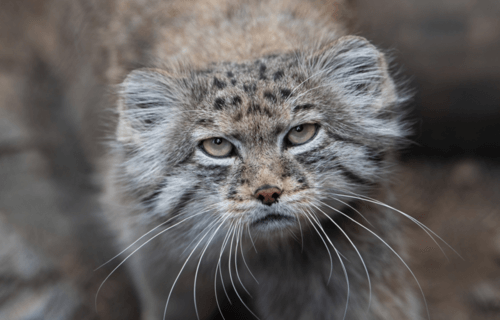NEW YORK — The Pallas’s cat has an unmistakable look. Sporting long, dense light gray fur, these felines look adorable and ill-tempered all at once. Pallas’s cats live in many different high-altitude regions such as the Caucuses, the Hindu Kush, and the Siberian mountains. Now, a new report confirms the first ever sighting of these beautiful felines on Mount Everest, in the Sagarmatha National Park in Nepal.
The 2019 National Geographic and Rolex Perpetual Planet Everest Expedition, the most comprehensive single scientific expedition to the famous mountain in history, made the four-legged find possible.
For just under a month (from April 7 to May 2, 2019), Dr. Tracie Seimon of Wildlife Conservation Society’s Zoological Health Program, based at the Bronx Zoo, co-led the Perpetual Planet Everest Expedition biology field team. The scientists diligently collected environmental samples from two locations roughly 3.7 miles apart at 16,765 and 17,027 feet above sea level along Sagarmatha National Park on Mount Everest’s Southern Flank.
“It is phenomenal to discover proof of this rare and remarkable species at the top of the world,” Dr. Seimon says in a media release. “The nearly four-week journey was extremely rewarding not just for our team but for the larger scientific community. The discovery of Pallas’s cat on Everest illuminates the rich biodiversity of this remote high-alpine ecosystem and extends the known range of this species to eastern Nepal.”

How many cats live on Everest?
The team performed a series of DNA analyses on scat samples from both areas, confirming the presence of two Pallas’s cats living on Mount Everest, as well as territory overlapping with nearby red fox populations. Additionally, researchers noted evidence of pika and mountain weasel DNA in the samples, both of which are important food sources in the Pallas’s cat’s diet. This discovery also adds the Pallas’s cat to the list of known mammals in Sagarmatha National Park, a heavily visited and protected World Heritage site.
“This is a unique discovery not only in terms of science but also conservation as this population of Pallas’s cat is legally protected under CITES (the Convention on International Trade in Endangered Species of Wild Fauna and Flora),” explains National Geographic Explorer and co-author of the paper Dr. Anton Seimon. “We hope that the confirmation of this new charismatic species will raise awareness of and education about the diversity of species at this iconic World Heritage Site.”
More and more humans are traveling to Everest
More and more tourists are flocking to Sagarmatha National Park and Mount Everest. In the 1970s, the area would see just a few thousand visitors annually. By 2019, over 50,000 tourists traveled to the area. Researchers say it is notable that the Pallas’s cat went undetected in the park until 2019. To that end, they say this discovery demonstrates how conservation genetics and environmental sampling can be game changers when it comes to uncovering and studying cryptic and elusive species like the Pallas’s cat.
Moving forward, the research team adds that future efforts including both camera trap surveys and collection of additional scat samples would go a long way toward settling on a more refined understanding of the Pallas’s cat population, range, density, and diet in Sagarmatha National Park.
“The groundbreaking 2019 Perpetual Planet Everest Expedition continues to be extremely valuable to better understand the most iconic environment on our planet,” adds Nicole Alexiev, Vice President of Science and Innovation Programs at National Geographic Society. “These results are a perfect illustration of why this work is important and a cornerstone of our partnership with Rolex to study and explore Earth’s critical life support systems.”
These findings are published in Cat News.


Why would one climb Mount Everest? Because it’s there… the Pallas cat, that is.
The cat probably does it to get away from man